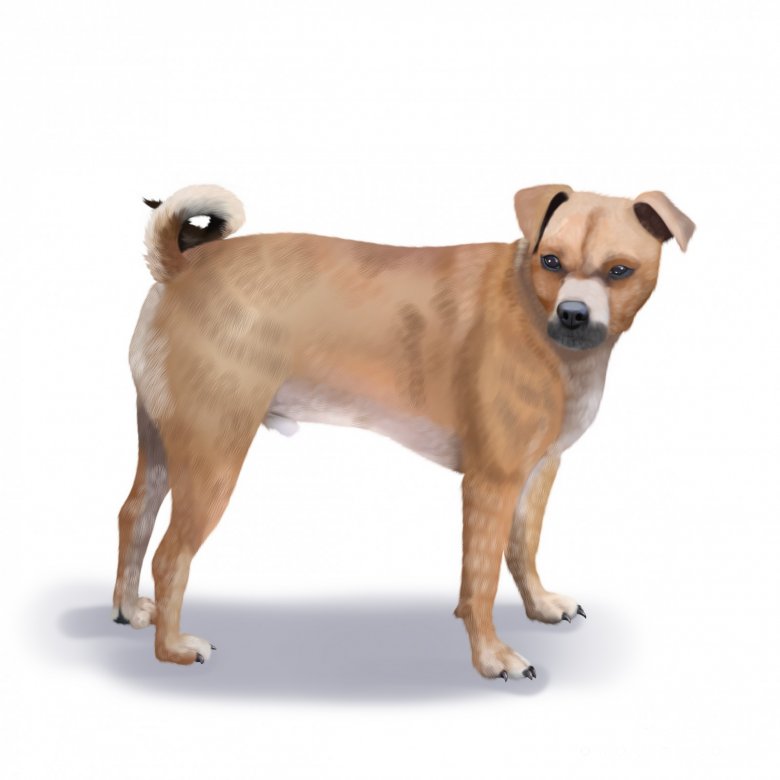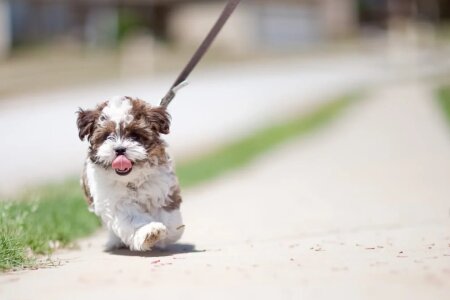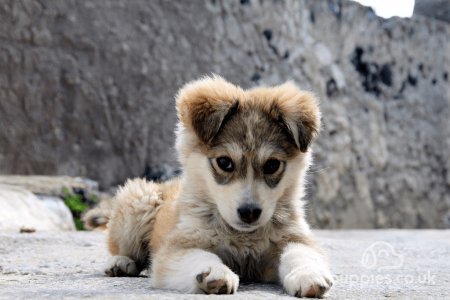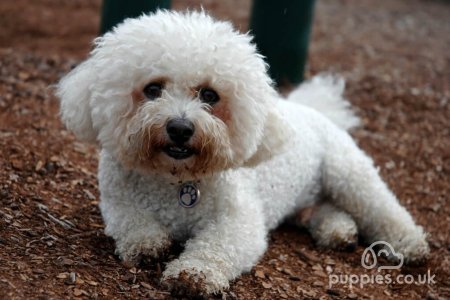Puggle (Pug X Beagle)
Overview
Mixing the qualities of the pug and beagle breeds, the beloved portmanteau puggle is a relative newcomer and a beloved companion for many owners in the UK. This American crossbreed inherits the positive traits of pugs and beagles whilst minimising the health issues common to both breeds. Puggles are amongst the most popular designer dog breeds that are unbelievably cute, and they retain their puppylike cuteness well into adulthood.
Physical Appearance
Puggles are a small breed that resemble its parent breeds, beagles and pugs. Individual puggles may resemble one breed more than another, so for instance one puggle may have the cute wrinkly face common to pugs whilst another may have a more elongated nose typical of beagles.
This breed can be recognised by its small, stocky frame and short legs. They have short, smooth fur coats with drooping ears and a characteristic tail that hangs gaily over its back. Although the appearance of their head can differ depending on whether the puggle inherits more of the pug or the beagle’s traits, it’s important to note that puggles tend to have longer noses than pugs, a brachycephalic breed that often suffers from breathing issues.
The colour of their fur coat can range from black and tan to lemon/white, tricolour, fawn, apricot/tan to all-black.
This breed is closely related to the beagle and the pug breeds, since it is a cross-breed of both.
How big do puggle dogs get?
Character Traits
Joyful and extroverted by nature, puggles have a lively temperament and are quite affectionate with their owners and their families. They inherit many of the positive temperament qualities of beagles and pugs, such as sociability, friendliness, and a strong desire to play. This latter trait means that they must be well-socialised and trained as puppies so that they don’t become too boisterous as they grow older.
Easy to train and highly intelligent, puggles are a superb choice for families and first-time pet owners. They can adapt fairly well to many environments, including apartments and small homes, although a garden and additional space to play and roam are always a plus.
Puggles are a crossbreed of designer dog, so their utility as a farm dog, watchdog, or guard dog are virtually nonexistent. Rather, puggles make for excellent companions in the home.
Are puggle dogs intelligent? Yes.
Are puggle dogs affectionate? Extremely.
Do puggle dogs have high or low energy levels? High energy.
Are puggle dogs loyal? Yes.
Are puggle dogs playful? Extremely.
Are puggle dogs aggressive? No.
Are puggle dogs easy to train? Yes.
Are puggle dogs good guard dogs? Not at all.
Ability to Socialise
Puggles are quite intelligent and can learn commands with relative ease, although they should be well-trained and socialised as puppies to ensure that poor temperament and behaviour do not develop early on.
Other dogs or cats in the home shouldn’t be a problem, since puggles tend to get along well with other pets. They are also very affectionate and playful with children, and they do not show aggressiveness towards strangers although excessive barking may be a problem.
Do puggle dogs get along with other pets? Yes, but they may chase small pets.
Do puggle dogs get along with other dogs? Yes.
Are puggle dogs good with kids? Yes.
Are puggle dogs good with strangers? Yes, but they may bark if not properly socialised.
Lifestyle Suitability
One of the greatest advantages of puggles is that they lend themselves well to owners living in urban and rural environments alike. Apartments, small homes, and large estates are all suitable living areas for a puggle, although plenty of outdoor exercise space is always a bonus. They are fairly tolerant to heat and cold, but a moderate climate is recommended.
Furthermore, puggles are an excellent choice of breed for families, first-time pet owners, and the elderly since they are highly social and friendly. Do note, however, that they also need to have someone at home at all times for mental and physical stimulation since they do not like being left alone for even short periods of time.
Are puggle dogs good for first-time owners? Definitely.
Are puggle dogs hypoallergenic? No.
Are puggle dogs prone to drooling? Yes, sometimes a lot of drooling.
Are puggle dogs a good breed for apartment living? Yes.
Do puggle dogs shed a lot? Despite their short coat, puggles shed a fair bit.
Do puggle dogs bark a lot? Yes.
Can puggle dogs be left alone at home? No.
Can puggle dogs handle the heat? Somewhat.
Can puggle dogs handle cold temperatures? Somewhat.
Are puggle dogs sensitive to loud noises? Yes.
General Health & Health Issues
Puggles are a fairly healthy breed, but they do have quite a few potential health concerns that owners should be informed of. Since their breeding is designed to minimise the downsides of pugs, quite often they do not suffer from breathing problems like pugs do, but they may inherit some of the problems typical of beagles and/or pugs.
If you’re looking to purchase or adopt a puggle, consider the following health problems typical of the breed:
Stenotic nares: this congenital disorder is also called ‘pinched nostrils,’ and one can imagine how this disorder can negatively affect the breathing of the puggle. Puggles with short muzzles are born with it, but the symptoms can be treated;
Hip dysplasia: this heritable condition can cause a fair bit of pain to puggles as they walk, and may lead to arthritic conditions as they age. It comes from the thighbone not fitting snugly with the hip joint;
Hypothyroidism: stemming from a lack of thyroid hormone, hypothyroidism can cause many problems such as obesity and infertility, but it can be treated;
Patellar luxation: an abnormal gait or lameness in the leg often means the dog is suffering from patellar luxation. Depending on severity, surgical intervention may be necessary.
How long do puggle dogs live? - 10-15 years
Exercise & Play Time
On account of their high energy levels, puggles require near-constant physical and mental stimulation in order to remain happy and well-behaved. They require a moderate amount of daily exercise outdoors, which can involve a morning walk and perhaps some more rigorous playtime in the evening, for example.
Inherited from their beagle cross, puggles tend to have a heightened sense of smell and hearing and will chase and play with many small pets or birds whenever given the opportunity. For this reason, you may wish to keep them on a lead in public spaces.
Note that puggles should never be left alone and isolated at home for too long. A family member should always be at home to provide for the puggle, otherwise he could become quite destructive.
How much exercise does a puggles dog need? - 30 minutes - 1 hour per day
Do puggle dogs like water play? Normally, yes, but they may encounter breathing problems when swimming.
Nutrition & Feeding
It is imperative that you follow a fairly strict feeding schedule with puggle puppies well into adulthood since they are highly prone to obesity if fed an improper diet. Limit treats to being given only for good behaviour during training and choose a high-quality diet such as raw or wet food rather than kibble, if possible.
Below are some rough estimates for how much your puppy/adult puggle requires, but keep in mind that every dog is unique and thus a personal dietary plan should be prepared.
Are puggles dogs prone to weight gain? Very much so.
How much should I feed a puggle puppy? About 100-170g per day, in three sessions.
How much should I feed an adult puggle dog? About 130-270g per day, in total.
Care & Maintenance
Puggles shed profusely, especially during spring and autumn, which means that you’ll need to keep a consistent cleaning routine to remove hair around the home. Their grooming needs, however, are fairly minimal. A simple weekly brush is all that’s really needed, but you should also provide them with plenty of emotional care and identify potential problems earlier rather than later.
- Grooming: puggles only need to be groomed once per week with a simple brush to remove dead hairs. Check their eyes and ears as you groom them to spot possible infections.
- Emotional care: never leave your puggle alone for too long, since they do not tolerate isolation well and can become destructive. They aren’t too challenging to train and can learn many commands with ease, but ensure that you do not punish him harshly.
History of the Puggle
Puggles were first crossbred in the 1980s by Wisconsin breeder Wallace Havens. Beagles and pugs were bred in order to retain the positive qualities of both whilst reducing the potential flaws in either, especially the breathing problems common to pugs. Nevertheless, pugs may still inherit the flaws of either or both.
It was not until the 1990s that puggles became more popular, and by the early 2000s, puggles had quickly become the most popular crossbreed in the United States. Although puggles are not a formally recognised breed as of 2021, The Puggle Club of America is seeking recognition to standardise the breeding of puggles.
Interesting Facts About Puggle Dogs
The puggle was named the ‘Hottest Dog of 2005’ in the United States.
In 2006, the sale of puggles in the United States accounted for over half of all crossbreed dog sales in the country.
Puggles may resemble a beagle or a pug whilst in the litter, which makes each and every puggle an adorable and unique pet for your home.
There is no formal recognition of puggles by kennel clubs, although some organisations are attempting to gain a formal recognition status.
Getting a Puggle Puppy
With such adorable and cute features, why wouldn’t you want a puggle all for yourself? They are wonderful pets, but it’s important to understand your role and responsibility when it comes to owning a puggle. There are, unfortunately, many breeders that engage in unethical practices and you shouldn’t support these operations. Instead, follow our buying guide and only purchase from reputable breeders. If you’d like to purchase a puggle, you’ve come to the right place. We only deal with reputable breeders.
How much does a puggle cost to buy? - About £400-£700.
How much does a puggle cost to feed? - An adult puggle costs about £0.60-£0.80 per day to feed.
How much does insurance for a puggle cost? - About £20-£40 per month.
Sensible alternatives to purchasing a new puggle puppy include rescue and adoption.











